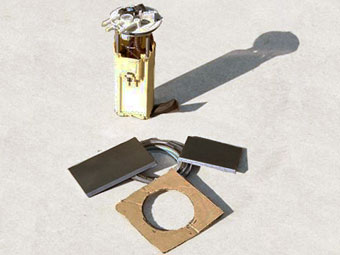
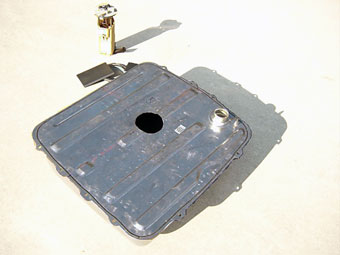
Installing an In-Tank Fuel Pump
as published in BritishV8 Magazine, Volume XVI Issue 2, October 2008by: Kelly Stevenson
In this article I'll describe how we installed an in-tank fuel-pump in my MGB. The conversion of my 1978 MGB tourer to Ford 5.0L V8 power was initially completed in May 2005. From the beginning, my conversion featured electronic fuel injection, but the initial installation featured an external fuel pump. That external fuel pump worked, but there are significant advantages to moving the fuel pump into the fuel tank. Most modern OEM installations have in-tank fuel pumps because they're quieter. They're also usually less susceptible to supply problems when the fuel level is low and when fuel is sloshing around during spirited driving.
Obviously, fitting an in-tank fuel pump requires cutting into the tank.
I suppose the traditional approach might be to cut and weld, but I believe
it's best to start with a brand-new tank and to preserve its modern,
corrosion-inhibiting coatings by soldering instead of by welding.
After shopping around, I ordered a new "Spectra Premium" 1977-80 spec
MGB fuel tank from an eBay merchant. The cost for the tank, including
shipping, is about $189. (Note: 1977-80 fuel tanks are most easily
identified by their short, straight-up, fuel-fuller inlet.)
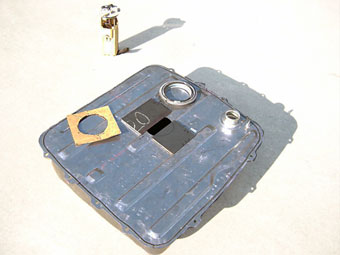
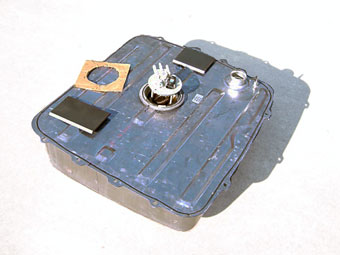
Editor's Notes: Spectra Premium Industries' MGB fuel tanks are made in Canada
from U.S. Steel's "Ni-Terne" material. The annealed cold-rolled steel sheet is
first processed to apply a thin flash coating of electrodeposited nickel,
and then it's given a hot-dip lead-tin alloy coating. The nickel base coat
gives Ni-Terne steel an extra measure of corrosion resistance compared to U.S.
Steel's regular "Terne" steel sheet and also compared to traditional
galvanizing, which isn't readily available anymore. It should also be pointed
out that the Ni-Terne coating protects both interior and exterior surfaces of
the fuel tank from surface corrosion.
Spectra Premium tanks are available directly from Moss Motors and Moss distributors.
Moss also sells British Motor Heritage brand fuel tanks, which are more
appropriate to use for concours restorations because they're made in England
on original MG tooling from plain steel sheet. British Motor Heritage fuel tanks
arrive painted black.
Painting the Spectra Premium fuel tanks isn't required or even recommended.
Per Kelvin Dodd at Moss Motors, for best paint adhesion you must clean the
tank very, very carefully to remove the oily film that covers it.
Notice: we have not measured or compared a Spectra Premium MGB fuel tank to
determine if they provide the same or more mounting depth for an in-tank fuel
pump as compared to original OEM or other aftermarket MGB fuel tanks. You should
measure before cutting...
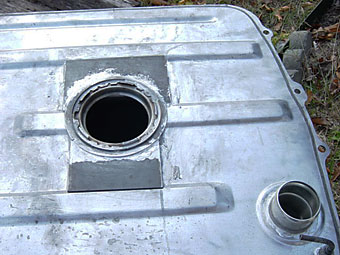
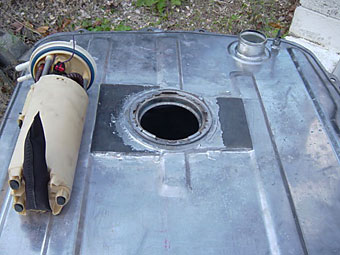
After the flange is soldered in, the module just drops in... but that's not the end of the job.
What about the fuel pump? I selected a modular fuel pump from a 1999 Chevrolet
Malibu. This fuel pump is convenient to use because it mates to a relatively
simple round flange in the horizontal top surface of a fuel tank. The Malibu
fuel pump module has more features than I chose to use - specifically it has
a built-in fuel level sensor. I won't be using this feature, so I removed the
float. I believe this pump's flow capacity is about 30 gallons per hour.
The Malibu fuel pump produces 60 psi. That's a lot more than I needed or wanted,
(probably too much for Ford's OEM fuel pressure regulator), but I'd already
invested in a Kirban (aftermarket) adjustable fuel pressure regulator which is
easily set to the appropriate 38-39 psi for my fuel injectors.
Actually, the fuel pump I used came with a complete Malibu fuel tank - from
the junk yard. The reason to start with a junk yard fuel pump is that you
need to cut the mounting flange from a donor tank. We used a pneumatic
reciprocating saw to cut out the flange. Once removed, we neatly marked a
circle around the flange, took it to a friend's shop, and used his belt sander
to trim the flange down to that marked line. This left a round flange lip that
looked good.
The top surface of an MGB fuel tank has embossed ribs, and we decided to
center the new fuel pump module over one of them. This embossment provided us
with a challenge, but we met it by soldering spacers to the tank to create a
flat mating plane. Specifically, we soldered two quarter-inch thick steel
plates to level the mounting surface. The edges of the steel filler plates
were radiused to match the tank's embossment. After the plates were soldered
onto the tank, the flange was soldered onto the plates and tank rib.
Enjoying this article? Our magazine is funded through the generous support of readers like you!
To contribute to our operating budget, please click here and follow the instructions.
(Suggested contribution is twenty bucks per year. Feel free to give more!)
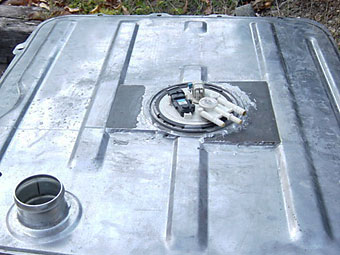
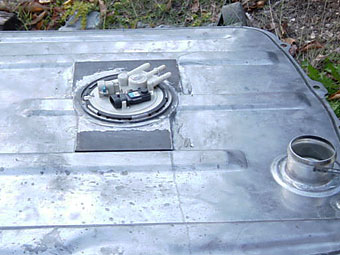
As you can see in the photos, there are three ports on the Malibu fuel pump assembly. The center port is a vapor vent. Since it's redundant with the vent port that the MGB tank already has (next to the fuel filler inlet), we capped the pump's vapor port. The other two ports are for inlet and for return. In some modern fuel injection systems the fuel injectors are provided more pressurized fuel than they can possibly use, and excess fuel is pumped right past the injector inlets and returned to the fuel tank.
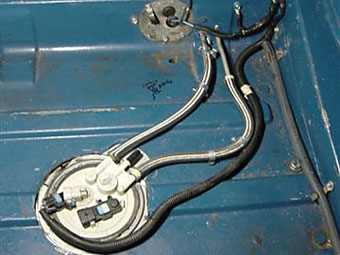
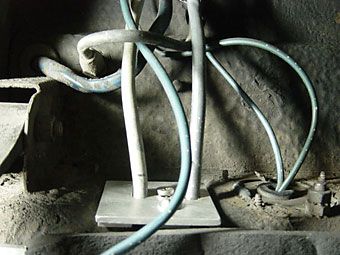
When it comes to wiring, we recommend that the fuel pump should be supplied from
a relay. Pumps are very sensitive to voltage; they don't perform their best when
they're operated at reduced power. A relay avoids this issue by eliminating
electrical resistance and subsequent voltage-drop in the fuel pump circuit. Power
is provided by a new lead, with an inline fuse, which is routed over from the battery.
A "signal" is still required from the ignition switch to turn the relay "on" and
"off". We used MG's original fuel pump lead for this purpose.
The Malibu fuel pump can move a great deal of fuel at relatively high pressure,
so in the event of an accident it needs to be turned "off" promptly and reliably.
For this reason, we also installed a new Ford fuel cut-off inertia switch on the
12V supply circuit. (Note: 1975-80 MGB's came with a white inertia switch on the
extreme righthand end of the firewall, cabin-side, but we chose to replace and
relocate this function on my car.)
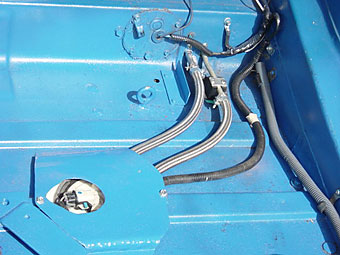
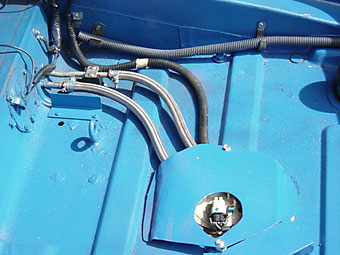
A final aspect of the installation was fitment of a sheetmetal shield to protect the module, fuel lines and wiring. My spare tire will still fit in the boot, over top this metal shield.
Disclaimer: This page was researched and written by Kelly Stevenson. Views expressed are those of the author, and are provided without warrantee or guarantee. Apply at your own risk.
Photos by Kelly Stevenson for British V8 Magazine. All rights reserved.


